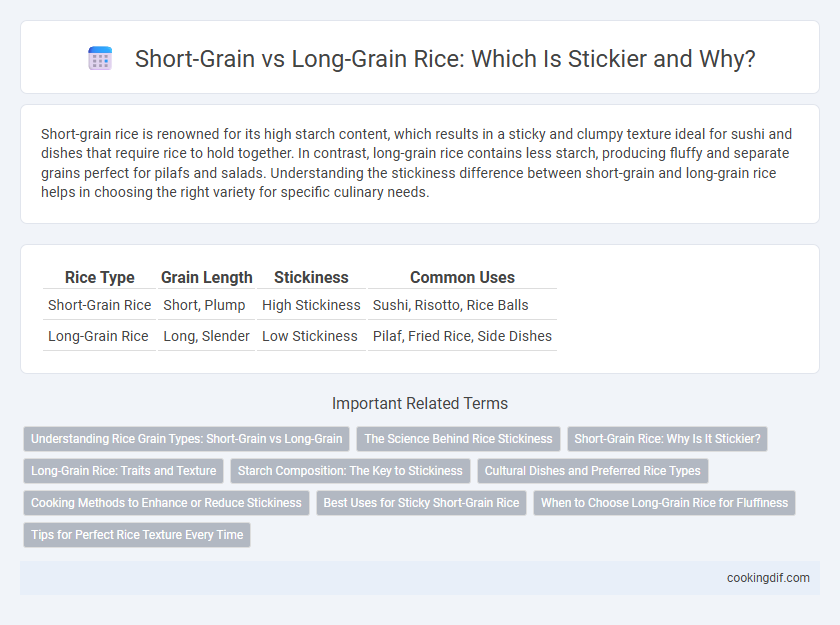Short-grain rice is renowned for its high starch content, which results in a sticky and clumpy texture ideal for sushi and dishes that require rice to hold together. In contrast, long-grain rice contains less starch, producing fluffy and separate grains perfect for pilafs and salads. Understanding the stickiness difference between short-grain and long-grain rice helps in choosing the right variety for specific culinary needs.
Table of Comparison
| Rice Type | Grain Length | Stickiness | Common Uses |
|---|---|---|---|
| Short-Grain Rice | Short, Plump | High Stickiness | Sushi, Risotto, Rice Balls |
| Long-Grain Rice | Long, Slender | Low Stickiness | Pilaf, Fried Rice, Side Dishes |
Understanding Rice Grain Types: Short-Grain vs Long-Grain
Short-grain rice contains higher amylopectin, resulting in a stickier texture ideal for sushi and risotto. Long-grain rice has a higher amylose content, making it drier and fluffier, perfect for pilafs and biryanis. Understanding these differences helps choose the right rice type for specific culinary applications.
The Science Behind Rice Stickiness
Short-grain rice contains higher amylopectin levels, a branched starch molecule responsible for its characteristic sticky texture when cooked. In contrast, long-grain rice has a greater proportion of amylose, a linear starch that absorbs less water and results in a fluffier, separate grain structure. The molecular composition of these starches directly impacts rice's water absorption and gelatinization process, determining the final stickiness and texture.
Short-Grain Rice: Why Is It Stickier?
Short-grain rice contains higher levels of amylopectin, a starch molecule responsible for its characteristic stickiness. This type of starch gelatinizes more effectively during cooking, causing the grains to cling together, making it ideal for dishes like sushi and risotto. In contrast, long-grain rice has more amylose, leading to a fluffier, less sticky texture.
Long-Grain Rice: Traits and Texture
Long-grain rice boasts slender, elongated kernels that cook up fluffy and separate, making it ideal for dishes requiring distinct grains like pilafs or biryanis. Its lower starch content compared to short-grain varieties ensures minimal stickiness and a dry, light texture. Popular types include Basmati and Jasmine, celebrated for their aromatic qualities and firm, non-clumpy consistency.
Starch Composition: The Key to Stickiness
Short-grain rice has a higher amylopectin content, which makes it stickier and ideal for dishes like sushi and risotto where clumping is desired. Long-grain rice contains more amylose, resulting in a drier, fluffier texture that separates easily after cooking. The starch composition, primarily the ratio of amylose to amylopectin, is the key factor determining the stickiness and overall texture of rice varieties.
Cultural Dishes and Preferred Rice Types
Short-grain rice is highly sticky due to its higher amylopectin content, making it the preferred choice for sushi, risotto, and Japanese or Korean dishes where clumping is essential. Long-grain rice has a lower starch content and remains fluffy and separate after cooking, ideal for Indian biryanis, Middle Eastern pilafs, and South American rice dishes. Cultural preferences often dictate rice selection, with short-grain favored in East Asian cuisine and long-grain dominating South Asian and Latin American culinary traditions.
Cooking Methods to Enhance or Reduce Stickiness
Short-grain rice contains a higher amylopectin content, which increases stickiness, making it ideal for dishes such as sushi and risotto that require clumping. Long-grain rice, with its higher amylose content, tends to remain separate and fluffy, suitable for pilafs and stir-fries. Cooking methods such as rinsing and draining reduce surface starch in short-grain rice to minimize stickiness, while techniques like using less water or steaming long-grain rice can enhance cohesiveness when desired.
Best Uses for Sticky Short-Grain Rice
Sticky short-grain rice, known for its high amylopectin content, clumps together when cooked, making it ideal for sushi, rice balls, and Korean dishes like bibimbap. Its unique texture is perfect for recipes requiring rice to hold its shape firmly without falling apart. Long-grain rice, by contrast, remains fluffy and separate, suited for pilafs and stir-fries where stickiness is undesirable.
When to Choose Long-Grain Rice for Fluffiness
Long-grain rice is ideal for dishes requiring separate, fluffy grains such as pilafs, biryanis, and fried rice due to its lower starch content, which prevents clumping. Its slender, elongated grains remain distinct and absorb flavors efficiently, making it perfect for recipes needing a light texture. Opt for long-grain rice when preparing meals where texture and grain separation are essential for the dish's success.
Tips for Perfect Rice Texture Every Time
Short-grain rice contains higher amylopectin content, making it naturally stickier and ideal for sushi and risotto. Long-grain rice has less amylopectin and more amylose, resulting in fluffy, separate grains perfect for pilafs and stir-fries. To achieve perfect rice texture, rinse grains to remove excess starch, measure water precisely according to grain type, and allow rice to rest covered after cooking for optimal moisture absorption.
Short-Grain vs Long-Grain for stickiness Infographic

 cookingdif.com
cookingdif.com